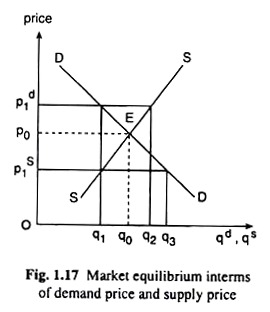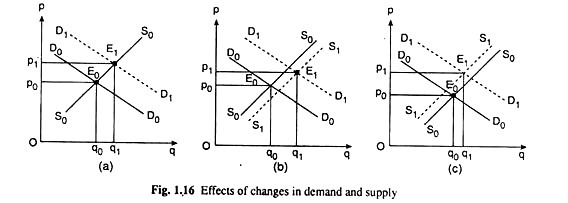In this article we will discuss about the market equilibrium in terms of demand price and supply price.
Let us first give the definitions. Demand price (pd) is the price that the buyers are willing to pay to demand a certain quantity (q) of the good.
At any q, demand price is obtained along the demand curve. For example, if the buyers want to pay a price of Rs 20 to demand 500 units, of the good per period, then the demand price at the quantity demanded of 500 units is Rs 20.
Demand price (pd) is a single valued function of quantity demanded (qd). This function is negative, i.e., as qd increases (or decreases), pd will fall (or rise), because of the law of demand which says that the buyers will demand a larger quantity only when they are asked to pay a smaller price.
ADVERTISEMENTS:
In terms of geometry, if the demand curve is given by DD in Fig. 1.17, then, at any quantity, q1, the demand price is p1d, for at this price, the quantity of q1 would be demanded. Supply price (ps), on the other hand, is defined as the price wanted by the suppliers of the good to supply a certain quantity.

Supply price (ps) is a single-valued function of quantity supplied (qs). This function is positive, i.e., as qs increases (or decreases), ps will rise or fall because of the law of supply which says that the producers will supply a larger quantity only if they get a larger price.
In terms of geometry, again, if the supply curve is given by SS in Fig. 1.16, then, at any quantity q1, the supply price is p1s, for, at this price the quantity of q1 would be supplied.
Now, if at a certain quantity like q1, the demand price of the good, p1d, is larger than its supply price, p1s then at the price of p1d quantity demanded would be q1 but quantity supplied would be larger, it would be q2 (since the demand price is larger than the supply price).
Therefore, in the competitive market, the price would be falling, and, consequently, qd would be rising and qs would be falling till the market reaches the equilibrium at qd = qs = q0 and pd = ps = p0 at the point E which is the point of intersection of the demand and supply curves.
Looking from the other side, if, at the quantity q1 the supply price p1s is smaller than the demand price p1d,.then at the price of p1s, the quantity supplied will be q1 but the quantity demanded would be larger (since supply price is less than the demand price), it would be q3.
Therefore, now the price in the market would be rising, and consequently, qs would be rising and qd falling, till the market is in equilibrium at qd = qs = q0 and pd = ps = p0 at the point of intersection, E, between the DD and SS curves.
